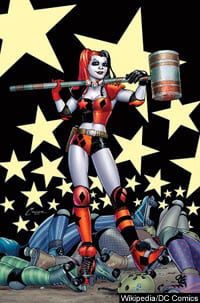September 16, 2013
If you or someone you know is experiencing a mental health, suicide or substance use crisis or emotional distress, reach out 24/7 to the 988 Suicide and Crisis Lifeline (formerly known as the National Suicide Prevention Lifeline) by dialing or texting 988 or using chat services at 988lifeline.org to connect to a trained crisis counselor. You can also get crisis text support via the Crisis Text Line by texting NAMI to 741741.

It’s a safe bet that few people start the day expecting to protest a comic book. Unfortunately, that’s what happened last week after DC Comics announced a “talent search” for an additional artist for the upcoming launch of a Harley Quinn comic book.
Harley Quinn is a fictitious super-villain and sidekick to one of Batman’s arch-enemies, the Joker. She’s about to get her own comic book in November. The problem is that DC Comics invited aspiring artists to submit for four panels that end with “Harley sitting naked in a bathtub with toasters, blow dryers, blenders, appliances all dangling above the bathtub and she has a cord that will release them all…the moment before the inevitable death.” Apparently, the panels are intended to be a momentary dream sequence, but the imagery crossed a line with many comic book fans. Ironically, it also coincided with National Suicide Awareness Prevention Month.
NAMI and the American Foundation for Suicide Prevention (AFSP) and the American Psychiatric Association (APA) quickly joined to condemn the talent search’s theme and imagery. The issue was not simply the company’s insensitivity to millions of individuals and families who have been traumatized by a suicide attempt or lost someone to suicide.
“We know from research that graphic and sensational depictions of suicide can contribute to contagion,” declared the joint statement
“Contagion” is sometimes called the “copycat” effect. A news story or media portrayal can influence a vulnerable person to already vulnerable person to act.
In Night Falls Fast: Understanding Suicide, Kay Redfield Jamison noted that places and methods can become “suicide magnets.” When a local newspaper reports for example that a certain mountain cliff has been the site of several recent suicides, others may be drawn to it—unless the newspaper is careful how the story is presented.
It’s not a new concern. Over a decade ago, AFSP, NAMI and others developed Recommendations for Reporting on Suicide. Although developed primarily for the news media, they apply in principle to the entertainment industry.
- There are almost always multiple causes for suicide, including psychiatric illnesses that may not have been recognized or treated Avoid reporting that death by suicide was preceded by a single event, such as a recent job loss, divorce or bad grades.
- Avoid sensational headlines or putting expert opinions in a sensationalistic context. Don’t quote first responders about possible causes.
- Avoid photos or videos of the location or method of a suicide death or of grieving family members and friends or memorials and funerals.
- Inform readers about general suicide facts, warning signs and treatment options. Include the National Suicide Prevention Lifeline at (800) 273-TALK (8255).
DC Comics has apologized “to anyone offended.” By the end of the week, they initiated a dialogue with AFSP, NAMI and APA. We’ll now have to see what the first issue of the book presents in the four panels when it is published in November. There are no promises, but they at least have been sensitized.
We don’t think DC Comics intended to offend or were even aware of “suicide contagion” as a concern. Unfortunately, they aren’t alone. That’s why we encourage everyone to become familiar with the reporting guidelines, to refer editors and reporters to them, and cite them in letters to editors or other public statements.
It is not just NAMI making the recommendation—but also the U.S. Centers for Disease Control and Prevention (CDC), National Institute of Mental Health, (NIMH) and other leading institutions in both the mental health community and communications industry.
Everyone can make a difference by educating others. One of the most inspiring aspects of the DC Comics protest was that comic book fans themselves sounded the first alarm—through posts on the company’s own Facebook web page, as well as ours. It has truly been a grassroots protest.
Submit To The NAMI Blog
We’re always accepting submissions to the NAMI Blog! We feature the latest research, stories of recovery, ways to end stigma and strategies for living well with mental illness. Most importantly: We feature your voices.
LEARN MORE